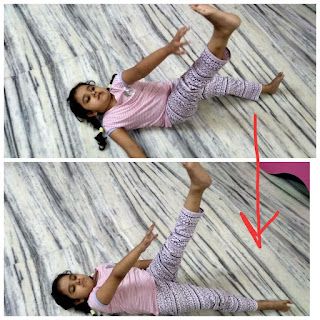W-sitting क्या है और इसके क्या alternatives हैं ये हैं पिछले blogs में discuss कर चुके हैं। www.consulltgeetanjali.com/w-sitting
 W-sitting एक असामान्य बैठने की अवस्था है जिसके कई negative परिणाम होते हैं। इसे एक temporary या transitional phase समझने की गलती न करें। बचपन में देखी जाने वाली w sitting के long term effects होते हैं।W-sitting position में hip joint अंदर की ओर rotated (internally rotated) हैं और knee joints बहार की तरफ rotated (externally rotated) हैं। ये position अगर लम्बे समय तक maintain की जाये तो ये lower limb के development पर बुरा असर डाल सकता है।
W-sitting एक असामान्य बैठने की अवस्था है जिसके कई negative परिणाम होते हैं। इसे एक temporary या transitional phase समझने की गलती न करें। बचपन में देखी जाने वाली w sitting के long term effects होते हैं।W-sitting position में hip joint अंदर की ओर rotated (internally rotated) हैं और knee joints बहार की तरफ rotated (externally rotated) हैं। ये position अगर लम्बे समय तक maintain की जाये तो ये lower limb के development पर बुरा असर डाल सकता है।  1. Poor core: W-sitting में wide base of support होने के कारण stability ज्यादा होती है और बच्चे को खुद को erect posture में maintain करने के लिए core muscles को activate करने की आवश्यकता नहीं होती जिस वजह से core muscles weakness हो जाती है।
1. Poor core: W-sitting में wide base of support होने के कारण stability ज्यादा होती है और बच्चे को खुद को erect posture में maintain करने के लिए core muscles को activate करने की आवश्यकता नहीं होती जिस वजह से core muscles weakness हो जाती है।
2. Slouch posture: core muscle की weakness की वजह से pelvis पीछे की तरफ tilt (posterior pelvic tilt) हो जाती है जिसके कारण बच्चा Slouch posture बैठता है और erect posture नहीं maintain कर सकता।
3. delayed fine motor development: fine motor development का सीखा तलूक exploration से है। बच्चा जीता ज्यादा अपने environment को explore करता है उतना ही उसकी learning और fine motor skills develop होतीं हैं। W-sitting में stability के कारण trunk movements (extension और side bending) दोनों काम हैं और posterior pelvic tilt trunk extension को और लिमिट कर देता है। इन दोनों कारणों से midline crossing activities restrict हो जातीं हैं। midline crossing activities में कमी मतलब reach और exploration दोनों घट जाता है। इसी कारण W-sitting वाले बच्चों में delayed fine motor development देखा जाता है।
 4. hip pain: W-sitting में hip joint flexion, adduction और internal rotation की position में maintained रहता है और ये position hip joint की closed pack position है।closed pack position यनि वो position जिसमे joint stress सबसे ज्यादा होता है। W-sitting में maximum actetabulao - femoral contact के कारण hip joint stress maximum होता है जो eventually hip pain का कारण बंनता है।
4. hip pain: W-sitting में hip joint flexion, adduction और internal rotation की position में maintained रहता है और ये position hip joint की closed pack position है।closed pack position यनि वो position जिसमे joint stress सबसे ज्यादा होता है। W-sitting में maximum actetabulao - femoral contact के कारण hip joint stress maximum होता है जो eventually hip pain का कारण बंनता है।
5. Toe -in gait: maintained internal rotation की वजह से external rotation की range और abductor muscle की strength काम हो जाती है। तो पैर के excessive internal rotation की वजह से Toe -in gait मिलता है।
 6. knock knees और knee pain: hip joint पर होने वाले internal rotation के compensation में knee joint पर external rotation देखने को मिलता है, जिस कारण knock knees posture दिखता है। ये posture knee joint stress को बढ़ता है और knee pain का कारण बनता है।
6. knock knees और knee pain: hip joint पर होने वाले internal rotation के compensation में knee joint पर external rotation देखने को मिलता है, जिस कारण knock knees posture दिखता है। ये posture knee joint stress को बढ़ता है और knee pain का कारण बनता है।
W-sitting के कारण ये सारी समस्याएं हैं मगर यदि बच्चा इनमे से कोई भी लक्ष्ण दिखाए तो तुरंत physical therapist से consult करें:-
लंगड़ाना
पैरों की कमज़ोरी
pegion toe gait
low muscle tone
clumsiness
fine motor activities में परेशानी
More on W-sitting coming next Friday right here.
Disclaimer : the information and views in the blog are personal experiences and details from Physical therapy clinic as observed by the Therapist. Any use of above information should only be undertaken under medical supervision of a certified Physical therapist
With love. ...your Physical Therapist is a health blog under Healthy Mom
www.healthymomshome.com




























